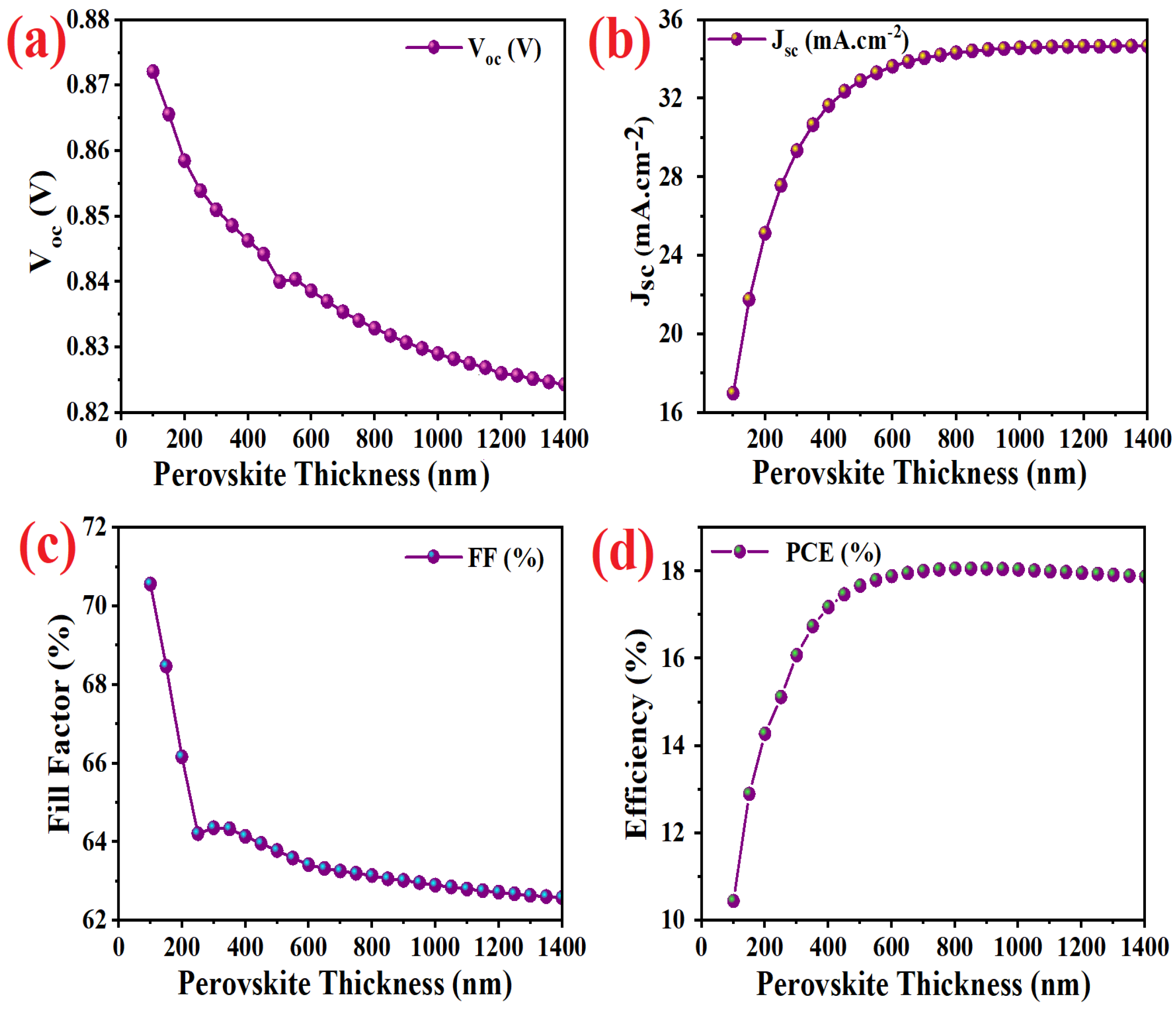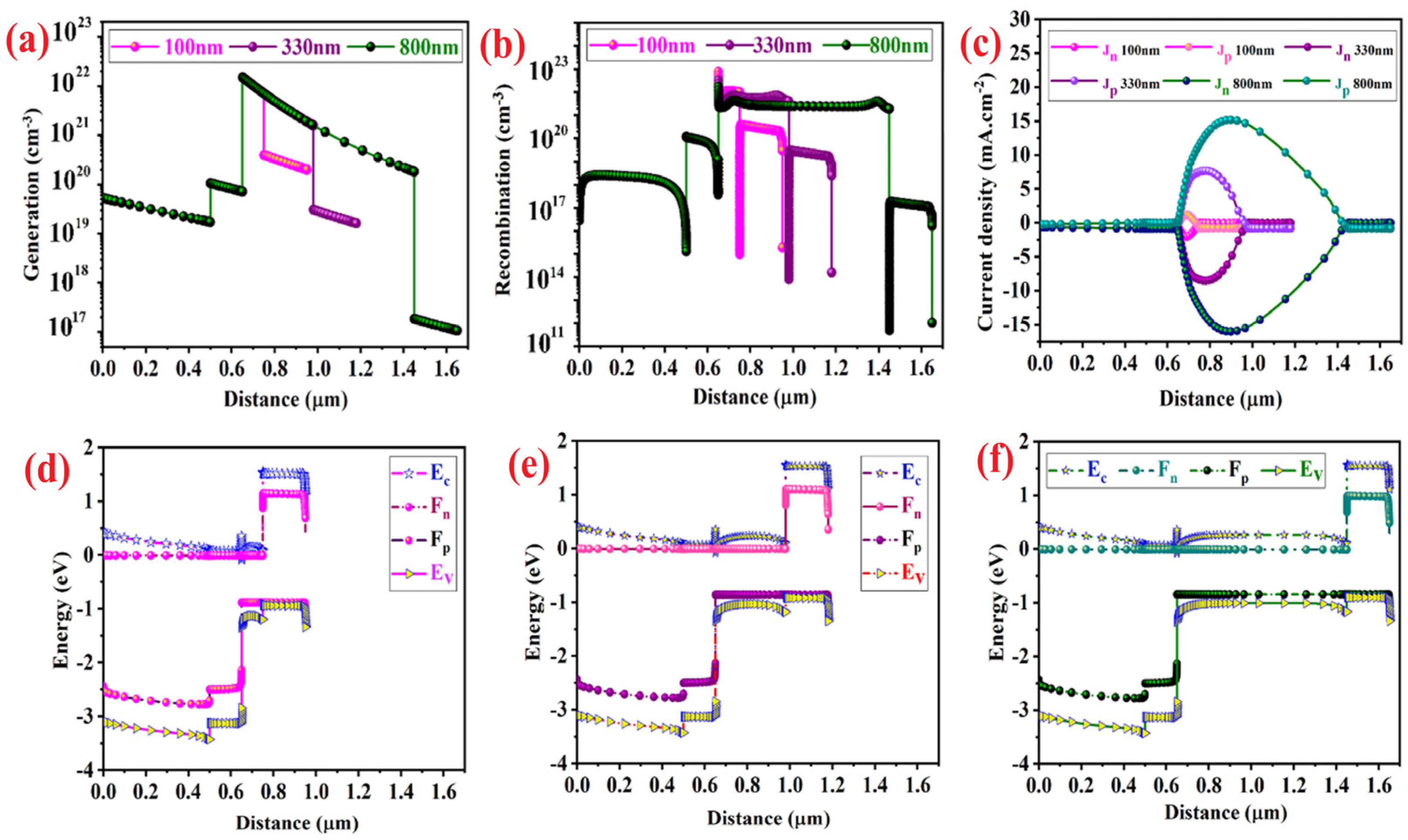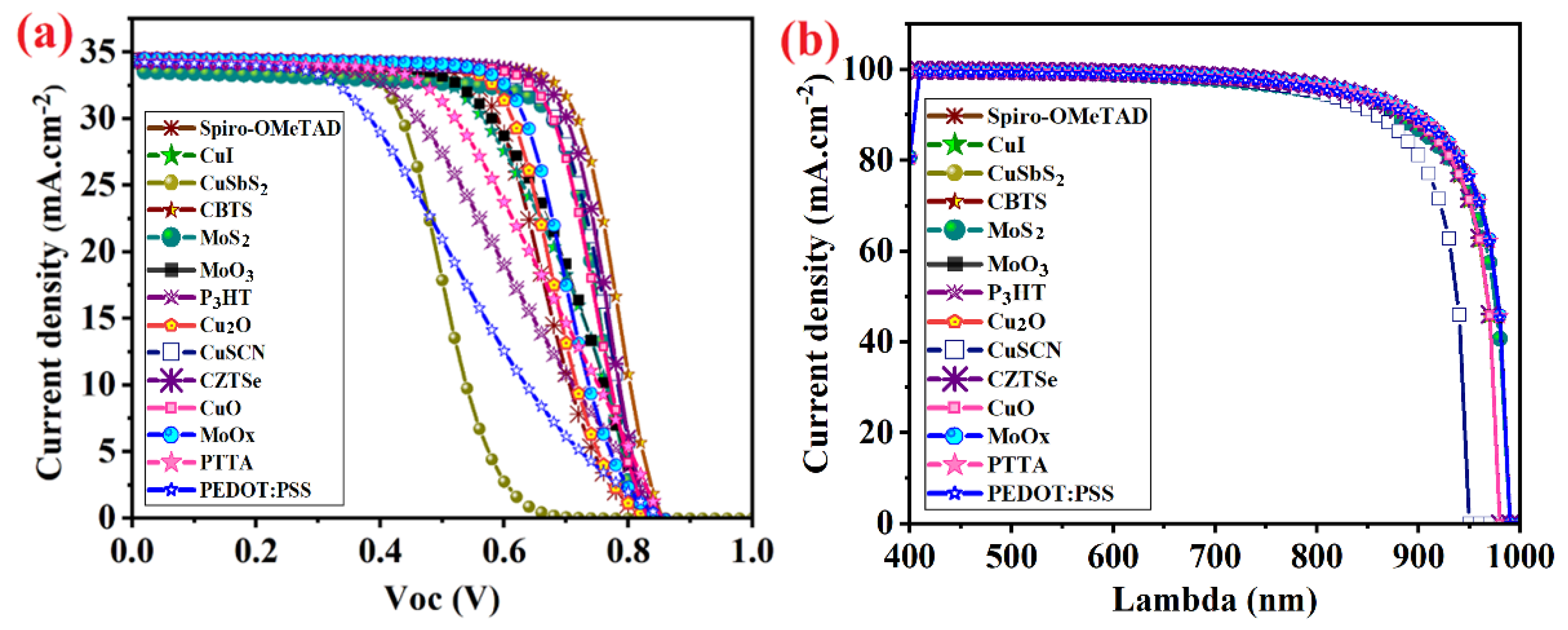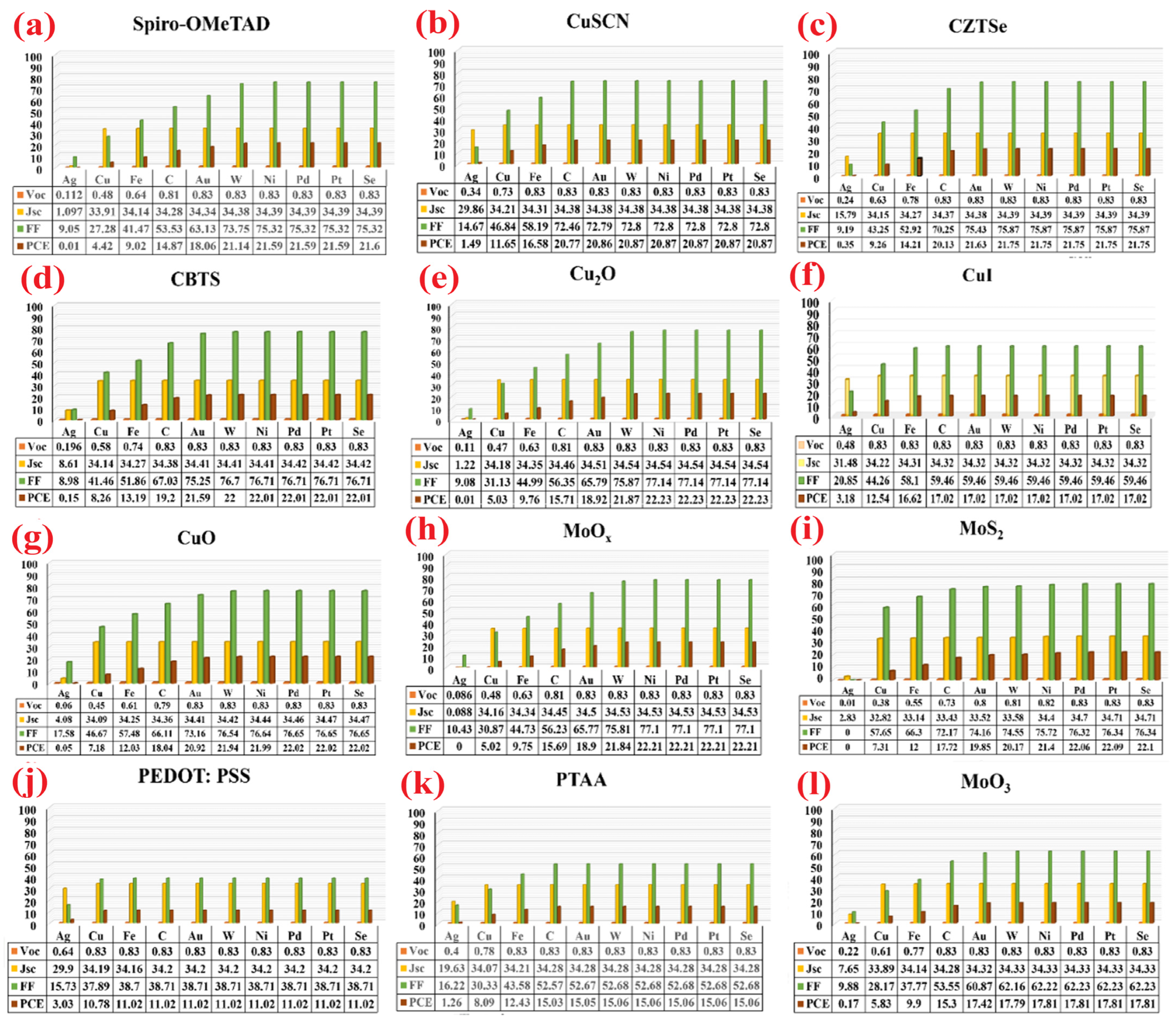A Comprehensive Study of CsSnI3-Based Perovskite Solar Cells with Different Hole Transporting Layers and Back Contacts
Abstract
:1. Introduction
2. Theoretical Methods and Device Structures
2.1. Computational Simulation Details
2.2. Device Structure
3. Results and Discussions
3.1. Photovoltaic Characterization of Standard Device
3.2. Photovoltaic Characterization of Standard Device vs. Experimental Results and HTL Free Device
3.3. Photovoltaic Characterization of Simulated Device with HTL Modification
3.4. Photovoltaic Characterization of Simulated Device with HTL by Modification of Metal Back Contact
4. Conclusions
Author Contributions
Funding
Data Availability Statement
Acknowledgments
Conflicts of Interest
References
- Tu, Y.; Wu, J.; Xu, G.; Yang, X.; Cai, R.; Gong, Q.; Zhu, R.; Huang, W. Perovskite Solar Cells for Space Applications: Progress and Challenges. Adv. Mater. 2021, 33, 2006545. [Google Scholar] [CrossRef]
- Basumatary, P.; Agarwal, P. A short review on progress in perovskite solar cells. Mater. Res. Bull. 2022, 149, 111700. [Google Scholar]
- Deng, K.; Li, L. Optical Design in Perovskite Solar Cells. Small Methods 2020, 4, 1900150. [Google Scholar]
- Murugadoss, G.; Thangamuthu, R. Metals doped cesium based all inorganic perovskite solar cells: Investigations on Structural, morphological and optical properties. Sol. Energy 2019, 179, 151–163. [Google Scholar] [CrossRef]
- Seyed-Talebi, S.M.; Kazeminezhad, I.; Shahbazi, S.; Diau, G. Efficiency and Stability Enhancement of Fully Ambient Air Processed Perovskite Solar Cells Using TiO2 Paste with Tunable Pore Structure. Adv. Mater. Interfaces 2020, 7, 1900939. [Google Scholar] [CrossRef]
- Seyed-Talebi, S.M.; Kazeminezhad, I. Performance improvement of fully ambient air fabricated perovskite solar cells in an anti-solvent process using TiO2 hollow spheres. J. Colloid Interface Sci. 2020, 562, 125–132. [Google Scholar] [PubMed]
- Min, H.; Lee, D.Y.; Kim, J.; Kim, G.; Lee, K.S.; Kim, J.; Paik, M.J.; Kim, Y.K.; Kim, K.S.; Kim, M.G.; et al. Perovskite solar cells with atomically coherent interlayers on SnO2 electrodes. Nature 2021, 598, 444–450. [Google Scholar] [PubMed]
- Best Research-Cell Efficiency Chart. Available online: https://www.nrel.gov/pv/cell-efficiency.html (accessed on 17 July 2023).
- Saikia, D.; Betal, A.; Bera, J.; Sahu, S. Progress and challenges of halide perovskite-based solar cell—A brief review. Mater. Sci. Semicond. Process. 2022, 150, 106953. [Google Scholar]
- Iqbal, S.; Riaz, K.; Imran, H.; Khattak, Y.H.; Baig, F.; Ahmad, Z. Computational modelling of monolithically stacked perovskite/ silicon tandem solar cells using monofacial and bifacial designs. Optik 2020, 206, 163427. [Google Scholar]
- Wu, T.; Liu, X.; Luo, X.; Lin, X.; Cui, D.; Wang, Y.; Segawa, H.; Zhang, Y.; Han, L. Lead-free tin perovskite solar cells. Joule 2021, 5, 863–886. [Google Scholar]
- Nasti, G.; Abate, A. Tin Halide Perovskite (ASnX3) Solar Cells: A Comprehensive Guide toward the Highest Power Conversion Efficiency. Adv. Energy Mater. 2020, 10, 1902467. [Google Scholar] [CrossRef]
- Yu, B.B.; Chen, Z.; Zhu, Y.; Wang, Y.; Han, B.; Chen, G.; Zhang, X.; Du, Z.; He, Z. Heterogeneous 2D/3D tin-halides perovskite solar cells with certified conversion efficiency breaking 14%. Adv. Mater. 2021, 33, 2102055. [Google Scholar]
- Dimesso, L.; Das, C.; Stöhr, M.; Mayer, T.; Jaegermann, W. Properties of cesium tin iodide (Cs-Sn-I) systems after annealing under different atmospheres. Mater. Chem. Phys. 2017, 197, 27–35. [Google Scholar] [CrossRef]
- Chung, I.; Song, J.H.; Im, J.; Androulakis, J.; Malliakas, C.D.; Li, H.; Freeman, A.J.; Kenney, J.T.; Kanatzidis, M.G. CsSnI3: Semiconductor or Metal? High Electrical Conductivity and Strong Near-Infrared Photoluminescence from a Single Material. High Hole Mobility and Phase-Transitions. J. Am. Chem. Soc. 2012, 134, 8579–8587. [Google Scholar] [CrossRef]
- Zhang, M.; Chen, K.; Wei, Y.; Hu, W.; Cai, Z.; Zhu, J.; Ye, Q.; Ye, F.; Fang, Z.; Yang, L.; et al. Strategies for Optimizing the Morphology of CsSnI3 Perovskite Solar Cells. Crystals 2023, 13, 410. [Google Scholar] [CrossRef]
- Luna, P.S.; Pokharel, U.; Huisman, B.A.H.; Koster, L.J.A.; Palazon, F.; Bolink, H.J. Vacuum-Deposited Cesium Tin Iodide Thin Films with Tunable Thermoelectric Properties. ACS Appl. Energy Mater. 2022, 5, 10216–10223. [Google Scholar] [CrossRef]
- Shockley, W.; Queisser, H.J. Detailed Balance Limit of Efficiency of P-N Junction Solar Cells. J. Appl. Phys. 1961, 32, 510–519. [Google Scholar] [CrossRef]
- Kamarudin, M.A.; Hirotani, D.; Wang, Z.; Hamada, K.; Nishimura, K.; Shen, Q.; Toyoda, T.; Iikubo, S.; Minemoto, T.; Yoshino, K.; et al. Suppression of Charge Carrier Recombination in Lead-Free Tin Halide Perovskite via Lewis Base Post-treatment. J. Phys. Chem. Lett. 2019, 10, 5277–5283. [Google Scholar] [CrossRef]
- Mitzi, D.B.; Feild, C.A.; Schlesinger, Z.; Laibowitz, R.B. Transport, Optical, and Magnetic Properties of the Conducting Halide Perovskite CH3NH3SnI3. J. Solid State Chem. 1995, 114, 159–163. [Google Scholar] [CrossRef]
- Aktas, E.; Rajamanickam, N.; Pascual, J.; Hu, S.; Aldamasy, M.H.; Girolamo, D.D.; Li, W.; Nasti, G.; Ferrero, E.M.; Wakamiya, A.; et al. Challenges and strategies toward long-term stability of lead-free tin-based perovskite solar cells. Commun. Mater. 2022, 3, 104. [Google Scholar]
- Chen, Z.; Wang, J.J.; Ren, Y.; Yu, C.; Shum, K. Schottky solar cells based on CsSnI3 thin-films. Appl. Phys. Lett. 2012, 101, 093901. [Google Scholar]
- Kumar, M.H.; Dharani, S.; Leong, W.; Boix, P.P.; Baikie, T.; Ding, H.; Graetzel, M.; Mhaisalkar, S.G.; Mathews, N. Lead-Free Halide Perovskite Solar Cells with High Photocurrents Realized Through Vacancy Modulation. Adv. Mater. 2014, 26, 7122–7127. [Google Scholar] [PubMed]
- Wang, G.; Chang, J.; Bi, J.; Lei, M.; Wang, C.; Qiao, Q. Inorganic CsSnI3 Perovskite Solar Cells: The Progressand Future Prospects. Sol. RRL 2022, 6, 2100841. [Google Scholar]
- Qiu, X.; Cao, B.; Yuan, S.; Chen, X.; Qiu, Z.; Jiang, Y.; Ye, Q.; Wang, H.; Zeng, H.; Liu, J.; et al. From unstable CsSnI3 to air-stable Cs2SnI6: A lead-free perovskite solar cell light absorber with bandgap of 1.48 eV and high absorption coefficient. Sol. Energy Mater. Sol. Cells 2017, 159, 227–234. [Google Scholar]
- Ye, T.; Wang, K.; Hou, Y.; Yang, D.; Smith, N.; Magill, B.; Yoon, J.; Mudiyanselage, R.R.H.H.; Khodaparast, G.A.; Wang, K.; et al. Ambient-Air-Stable Lead-Free CsSnI3 Solar Cells with Greater than 7.5% Efficiency. J. Am. Chem. Soc. 2021, 143, 4319–4328. [Google Scholar]
- Lin, S.; Zhang, B.; Lü, T.Y.; Zheng, C.; Pan, H.; Chen, H.; Lin, C.; Li, X.; Zhou, J. Inorganic Lead-Free B-γ-CsSnI3 Perovskite Solar Cells Using Diverse Electron-Transporting Materials: A Simulation Study. ACS Omega 2021, 6, 26689–26698. [Google Scholar]
- Abate, A. Stable Tin-Based Perovskite Solar Cells. ACS Energy Lett. 2023, 8, 1896–1899. [Google Scholar]
- Ye, T.; Wang, X.; Wang, K.; Ma, S.; Yang, D.; Hou, Y.; Yoon, J.; Wang, K.; Priya, S. Localized Electron Density Engineering for Stabilized B-γCsSnI3-Based Perovskite Solar Cells with Efficiencies >10%. ACS Energy Lett. 2021, 6, 1480–1489. [Google Scholar]
- Sarkar, D.K.; Hasan, A.K.M.; Mottakin, M.; Selvanathan, V.; Sobayel, K.; Islam, M.A.; Muhammad, G.; Aminuzzaman, M.; Shahiduzzaman, M.; Sopian, K.; et al. Lead free efficient perovskite solar cell device Optimization and defect study using Mg doped CuCrO2 as HTL and WO3 as ETL. Sol. Energy 2022, 243, 215–224. [Google Scholar]
- Xie, L.; Zhang, L.; Hua, Y.; Ding, L. Inorganic electron-transport materials in perovskite solar cells. J. Semicond 2022, 43, 040201. [Google Scholar]
- Seyed-Talebi, S.M.; Beheshtian, J. Lead-Free Inorganic Cesium Tin-Germanium Triiodide Perovskites for Photovoltaic Application. Int. J. Energy Power Eng. 2021, 15, 252–257. [Google Scholar]
- Imani, S.; Seyed-Talebi, S.M.; Beheshtian, J.; Diau, E.W.G. Simulation and characterization of CH3NH3SnI3-based perovskite solar cells with different Cu-based hole transporting layers. Appl. Phys. A 2023, 129, 143. [Google Scholar] [CrossRef]
- Hossain, M.K.; Toki, G.F.I.; Kuddus, A.; Rubel, M.H.K.; Hossain, M.M.; Bencherif, H.; Rahman, M.F.; Islam, M.R.; Mushtaq, M. An extensive study on multiple ETL and HTL layers to design and simulation of high-performance lead-free CsSnCl3-based perovskite solar cells. Sci. Rep. 2023, 13, 2521. [Google Scholar] [CrossRef] [PubMed]
- Lin, L.; Jones, T.W.; Yang, C.J.; Duffy, N.W.; Li, J.; Zhao, L.; Chi, B.; Wang, X.; Wilson, G.J. Inorganic Electron Transport Materials in Perovskite Solar Cells. Adv. Funct. Mater. 2021, 31, 2008300. [Google Scholar]
- Niemegeers, A.; Burgelman, M.; Degrave, S.; Verschraegen, J.; Decock, K. SCAPS (Version: 3.3. 08) Manual November 7, 2018; University of Gent: Gent, Belgium, 2020. Available online: https://scaps.elis.ugent.be (accessed on 17 July 2023).
- Ashebir, G.Y.; Dong, C.; Wan, Z.; Qi, J.; Chen, J.; Zhao, Q.; Chen, W.; Wang, M. Solution-processed Cu2ZnSnSe4 nanoparticle film as efficient hole transporting layer for stable perovskite solar cells. J. Phys. Chem. Solids 2019, 129, 204–208. [Google Scholar]
- Li, J.; Huang, J.; Ma, F.; Sun, H.; Cong, J.; Privat, K.; Webster, R.F.; Cheong, S.; Yao, Y.; Chin, R.L.; et al. Unveiling microscopic carrier loss mechanisms in 12% efficient Cu2ZnSnSe4 solar cells. Nat. Energy 2022, 7, 754–764. [Google Scholar]
- Ravidas, B.K.; Roy, M.K.; Samajdar, D.P. Investigation of photovoltaic performance of lead-free CsSnI3-based perovskite solar cell with different hole transport layers: First Principle Calculations and SCAPS-1D Analysis. Sol. Energy 2023, 249, 163–173. [Google Scholar] [CrossRef]
- Jiang, M.; Tang, J. Simulated development and optimized performance of narrow-bandgap CsSnI3-based all-inorganic perovskite solar cells. J. Phys. D Appl. Phys. 2021, 54, 465104. [Google Scholar] [CrossRef]
- Pindolia, G.; Shinde, S.M.; Jha, P.K. Optimization of an inorganic lead free RbGeI3 based perovskite solar cell by SCAPS-1D simulation. Sol. Energy 2022, 236, 802–821. [Google Scholar]
- Srivastava, S.; Singh, A.K.; Kumar, P.; Pradhan, B. Comparative performance analysis of lead-free perovskites solar cells by numerical simulation. J. Appl. Phys. 2022, 131, 175001. [Google Scholar]
- Juarez-Perez, E.J.; Wuβler, M.; Fabregat-Santiago, F.; Lakus, K.; Wollny, K.; Mankel, E.; Mayer, T.; Jaegermann, W.; Mora-Sero, I. Role of the Selective Contacts in the Performance of Lead Halide Perovskite Solar Cells. J. Phys. Chem. Lett. 2014, 5, 680–685. [Google Scholar] [CrossRef] [PubMed]
- Madan, J.; Singh, K.; Pandey, R. Comprehensive device simulation of 23.36% efficient two-terminal perovskite-PbS CQD tandem solar cell for low-cost applications. Sci. Rep. 2021, 11, 19829. [Google Scholar] [CrossRef] [PubMed]
- Ni, Z.; Bao, C.; Liu, Y.; Jiang, Q.; Wu, Q.; Chen, S.; Dai, X.; Chen, B.; Hartweg, B.; Yu, Z.; et al. Resolving spatial and energetic distributions of trap states in metal halide perovskite solar cells. Science 2020, 397, 1352–1358. [Google Scholar] [CrossRef] [PubMed]
- Chen, L.-J.; Lee, C.-R.; Chuang, Y.-J.; Wu, Z.-H.; Chen, C. Synthesis and Optical Properties of Lead-Free Cesium Tin Halide Perovskite Quantum Rods with High-Performance Solar Cell Application. J. Phys. Chem. Lett. 2016, 7, 5028–5035. [Google Scholar]







| Parameters | Nt (1/cm3) | ND (cm−3) | NA (cm−3) | ε | µp (cm2v−1s−1) | µn (cm2v−1s−1) | Nv (cm−3) | NC (cm−3) | χ (eV) | Eg (eV) | Thickness (µm) |
|---|---|---|---|---|---|---|---|---|---|---|---|
| FTO | 1.0 × 10+15 | 1.0 × 10+15 | 0 | 9 | 10 | 20 | 1.8 × 10+19 | 2.0 × 10+18 | 4.0 | 3.5 | 0.500 |
| TiO2 | 1.0 × 10+17 | 5.0 × 10+19 | 0 | 9 | 10 | 20 | 2.0 × 10+20 | 1.0 × 10+21 | 4.0 | 3.2 | 0.150 |
| CsSnI3 | 1.0 × 10+13 | 0.0 | 1.8 × 10+16 | 18 | 4.37 | 4.37 | 1.0 × 10+19 | 1.0 × 10+19 | 4.47 | 1.27 | 0.803 |
| Spiro-OMeTAD | 1.0 × 10+15 | 0.0 | 2.0 × 10+18 | 3 | 2.0 × 10−4 | 2.0 × 10−4 | 1.9 × 10+19 | 2.2 × 10+18 | 3 | 2.45 | 0.200 |
| CuSCN | 1.0 × 10+15 | 0.0 | 1.0 × 10+18 | 10.0 | 25.0 | 100 | 1.8 × 10+18 | 2.8 × 10+19 | 1.4 | 3.8 | 0.200 |
| Cu2O | 1.0 × 10+15 | 0.0 | 1.0 × 10+18 | 7.5 | 80 | 200 | 1.0 × 10+19 | 2.0 × 10+19 | 3.4 | 2.2 | 0.200 |
| CuI | 1.0 × 10+15 | 0.0 | 1.0 × 10+18 | 6.5 | 43.9 | 100 | 1.0 × 10+19 | 2.8 × 10+19 | 2.1 | 3.1 | 0.200 |
| CuSbS2 | 1.0 × 10+15 | 0.0 | 1.0 × 10+18 | 14.6 | 49 | 49 | 1.0 × 10+19 | 2.0 × 10+18 | 4.2 | 1.58 | 0.200 |
| CZTSe | 1.0 × 10+15 | 0.0 | 5.0 × 10+16 | 9.1 | 40 | 145 | 1.8 × 10+19 | 2.2 × 10+18 | 1.00 | 4.46 | 0.200 |
| CBTS | 1.0 × 10+15 | 0.0 | 1.0 × 10+18 | 5.4 | 10 | 30 | 1.8 × 10+19 | 2.2 × 10+18 | 3.6 | 1.9 | 0.200 |
| CuO | 1.0 × 10+15 | 0.0 | 1.0 × 10+18 | 18.1 | 0.1 | 100 | 5.5 × 10+20 | 2.2 × 10+19 | 4.07 | 1.51 | 0.200 |
| MoS2 | 1.0 × 10+15 | 0.0 | 1.0 × 10+17 | 13.6 | 150 | 100 | 1.8 × 10+19 | 2.2 × 10+18 | 4.2 | 1.29 | 0.200 |
| MoOX | 1.0 × 10+15 | 0.0 | 5.0 × 10+17 | 10 | 2.5 | 30 | 2.5 × 10+17 | 3.2 × 10+16 | 2.3 | 3.2 | 0.200 |
| MoO3 | 1.5 × 10+17 | 0.0 | 1.0 × 10+18 | 5.7 | 1.0 × 10−4 | 1.0 × 10−4 | 4.343 × 10+19 | 4.386 × 10+19 | 2.3 | 3 | 0.200 |
| PTAA | 1.0 × 10+15 | 0.0 | 1.0 × 10+18 | 9 | 40 | 1 | 1.0 × 10+21 | 1.0 × 10+21 | 2.3 | 2.96 | 0.200 |
| P3HT | 1.0 × 10+15 | 0.0 | 1.0 × 10+18 | 3 | 1.86 × 10−2 | 1.8 × 10−3 | 2.0 × 10+21 | 2.0 × 10+21 | 3.5 | 1.7 | 0.200 |
| PEDOT:PSS | 1.0 × 10+15 | 0.0 | 1.0 × 10+18 | 3 | 4.5 × 10−2 | 4.5 × 10−2 | 1.8 × 10+19 | 2.2 × 10+18 | 3.4 | 1.6 | 0.200 |
| HTL | Voc (V) | Jsc (mA.cm−2) | FF | PCE (%) |
|---|---|---|---|---|
| HTL-free | 0.54 | 32.15 | 66.58 | 11.62 |
| Spiro-OMeTAD (exp) | 0.86 | 23.20 | 65.00 | 12.96 |
| Spiro-OMeTAD (330 nm) | 0.86 | 23.09 | 65.02 | 12.96 |
| Spiro-OMeTAD (800 nm) | 0.83 | 34.34 | 63.13 | 18.06 |
| Cu2O | 0.83 | 34.51 | 65.79 | 18.92 |
| CuI | 0.83 | 34.31 | 59.46 | 17.02 |
| CuSCN | 0.83 | 34.38 | 72.79 | 20.87 |
| CuSbS2 | 0.72 | 34.47 | 53.00 | 13.23 |
| Cu2ZnSnSe4 | 0.83 | 34.39 | 75.43 | 21.63 |
| CBTS | 0.83 | 34.41 | 72.25 | 21.59 |
| CuO | 0.83 | 34.41 | 73.16 | 20.92 |
| MoS2 | 0.80 | 33.52 | 74.16 | 19.85 |
| MoOX | 0.83 | 34.50 | 65.76 | 18.91 |
| MoO3 | 0.83 | 34.32 | 60.87 | 17.42 |
| PTTA | 0.83 | 34.28 | 52.67 | 15.06 |
| P3HT | 0.83 | 34.24 | 46.44 | 13.26 |
| PEDOT:PSS | 0.83 | 34.20 | 38.71 | 11.02 |
Disclaimer/Publisher’s Note: The statements, opinions and data contained in all publications are solely those of the individual author(s) and contributor(s) and not of MDPI and/or the editor(s). MDPI and/or the editor(s) disclaim responsibility for any injury to people or property resulting from any ideas, methods, instructions or products referred to in the content. |
© 2023 by the authors. Licensee MDPI, Basel, Switzerland. This article is an open access article distributed under the terms and conditions of the Creative Commons Attribution (CC BY) license (https://creativecommons.org/licenses/by/4.0/).
Share and Cite
Seyed-Talebi, S.M.; Mahmoudi, M.; Lee, C.-H. A Comprehensive Study of CsSnI3-Based Perovskite Solar Cells with Different Hole Transporting Layers and Back Contacts. Micromachines 2023, 14, 1562. https://doi.org/10.3390/mi14081562
Seyed-Talebi SM, Mahmoudi M, Lee C-H. A Comprehensive Study of CsSnI3-Based Perovskite Solar Cells with Different Hole Transporting Layers and Back Contacts. Micromachines. 2023; 14(8):1562. https://doi.org/10.3390/mi14081562
Chicago/Turabian StyleSeyed-Talebi, Seyedeh Mozhgan, Mehrnaz Mahmoudi, and Chih-Hao Lee. 2023. "A Comprehensive Study of CsSnI3-Based Perovskite Solar Cells with Different Hole Transporting Layers and Back Contacts" Micromachines 14, no. 8: 1562. https://doi.org/10.3390/mi14081562
APA StyleSeyed-Talebi, S. M., Mahmoudi, M., & Lee, C.-H. (2023). A Comprehensive Study of CsSnI3-Based Perovskite Solar Cells with Different Hole Transporting Layers and Back Contacts. Micromachines, 14(8), 1562. https://doi.org/10.3390/mi14081562






